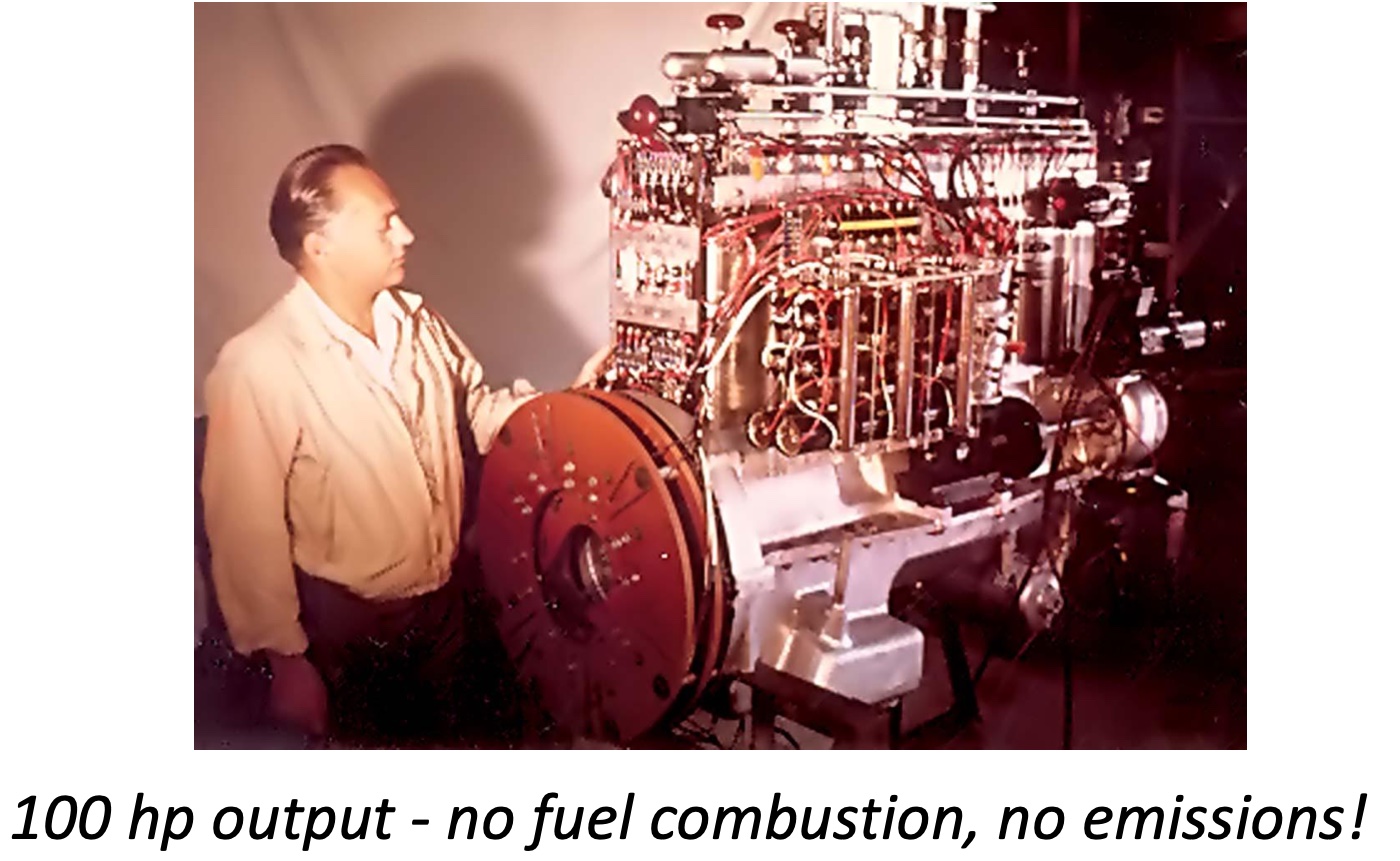
Josef Papp
Born in Hungary in 1933.
Emigrated through Canada to U.S. in 1957.
Developed a plasma transition engine in 1960s.
Patented his “Method for Converting Atomic Energy into Utilizable Kinetic Energy” in 1972.
His engine operated on stable noble gases.
Contained some Thorium, Rubidium & Phosphorous, but insufficient for known nuclear power reactions.
The PAP Noble Gas Motor, developed by Joseph Papp, was an innovative engine concept that ran on a mixture of noble gases, including helium, neon, argon, krypton, and xenon. The idea behind this motor was that it could produce energy by exploiting the properties of these gases in a controlled plasma state, with claims that the motor could run efficiently and at very low cost, potentially offering an overunity system. Overunity refers to a system that produces more energy output than the energy input, a concept not recognized by mainstream physics.
Papp's motor gained significant attention when it was publicly demonstrated. However, the demonstration on November 18, 1968, in Gardena, California, ended in disaster. Reportedly, the Nobel Prize-winning physicist Richard Feynman, who had been invited to observe the motor, unplugged a key component, leading to an explosion that resulted in the deaths of several people. The incident caused Papp's motor to be dismissed as dangerous and unscientific, though some supporters of Papp suggest that the unplugging was a form of deliberate sabotage to protect established energy industries and interests. It's a matter of debate whether the explosion was truly accidental or if Feynman’s actions were, as you suggest, motivated by external pressures to suppress overunity technology.
In a similar vein, the Roberts Rotary Noble Gas Engine, developed by Dannel Roberts and built by Robert Rohner, represents another effort to harness noble gases in a plasma state for energy production. This engine gained attention for its simplicity and mechanical design, as demonstrated in videos showing its operation. However, just as this project appeared ready to move forward, it reportedly faced government intervention, with allegations that U.S. agencies (perhaps the FBI or similar entities) seized their funds and assets. The reasons for this intervention remain unclear but suggest a pattern of suppression for technologies that challenge conventional energy systems. The market for such a device remains vast, and many continue to hope that someone can bring a working, safe version to market. [anon]
Reference Material
- David Ansley, The Dream Machine, San Jose Mercury News, August 27, 1989 (reprint)
- Atomic Cluster Application
- Atomic Cluster Charge build-up
- Atomic Cluster Expansion
- Atomic Cluster Experimental Apparatus
- Atomic Cluster Heating
- Atomic Cluster Introduction
- Atomic Cluster Ionization
- Atomic Cluster Nuclear Fusion
- Atomic Cluster X-Ray Emission
- Atomic Clusters
- Electron Orbits, video
- Electron Orbits, video
- Electron Orbits of He and H2, video
- Feynman, Papp engine, LASER- Journal of the Southern Californian Skeptics
- Formation of Atomic Clusters
- FuseEdWeb - Fusion Energy Education
- Hall Effect Sensor
- Interaction of Intense Laser Pulses with Atomic Clusters - Measurements of Ion Emission Simulations and Applications
- Ion Energies from Atomic Cluster Explosions
- Irving Langmuir and Atomic Hydrogen, Nicholas Moller
- Laser Cluster Interactions
- Lawton Circuit, Spark Plug
- Models of Laser Cluster Interactions
- Moller Atomic Hydrogen Generator Project
- Nassim Taleb, The Black Swan, Random House, 2010.
- Noble Gas, Discharge Color images
- Noble Gas Ionization
- Numerical Simulation of an Atomic Cluster Explosion
- Pachen's Law
- Pachen's Law
- Papp Engine - Origin and General History
- Papp machine reconstruction at Tesla Tech conference
- Plasma in Globe, video
- Plasma Ionization
- PlasmErg Popper Kit
- Robert Rohner, Plasma transition demonstrations and spectra
- Robert Rohner, Rohner Machine Works
- Rohner Group material - reconstruction and testing of the Papp engine
- Rohner, Inteligentry Home Page
- RWGResearch.com - Open Forum
- Satori, Jimmy; Papp Engine, video
- Springer, Barry - The Revolutionary Plasma Power Technology of Josef Papp
- Sterling Allen, How the “Plasmic Transition Process†motor system works
- Sterling Allen, Inteligentry to Debut at Power-Gen, Pure Energy Science News
- Update 11 NGE Papp: Hydrogen To Plasma Will Do Mechanical Work? This May Be Better?, video
- U.S. Patent App. 20110113772
- U.S. Patent 3,670,494
- Wikipedia, Internal combustion cycle engine
- Wikipedia, Josef Papp
- World Science Database, Josef Papp
See Also
16.14 - Thermionic and gaseous state diodes
Atomic Dissociation
Browns Gas
Dispersion
Dissociation
Etheric Elements
Etheric Vapor
Gas-Plasma-Gas Transformation
Inert Gas
Josef Papp
Law of Atomic Dissociation
Law of Chemical Dissociation
Law of Oscillating Atoms
Law of Repulsion
Law of Transformation of Forces
Law of Variation of Atomic Oscillation by Electricity
Lingasarira
Molecular Dissociation
Noble gas
plasma
Robert Rohner
Quark-Gluon Plasma
transformation
Transmutation
Water Gas
